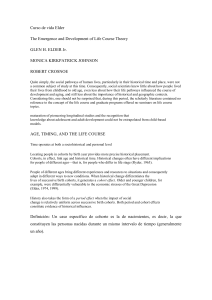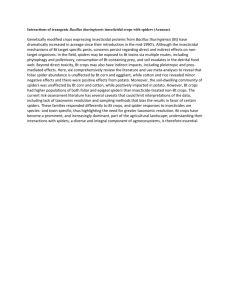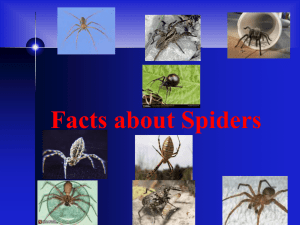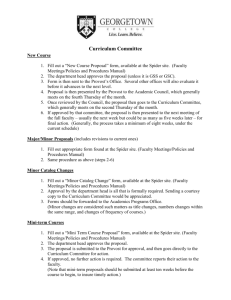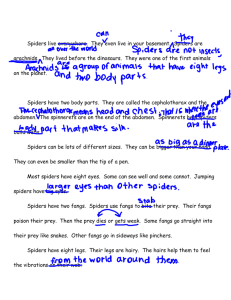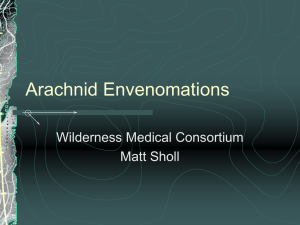Introduction - Journal of Medical Entomology
advertisement
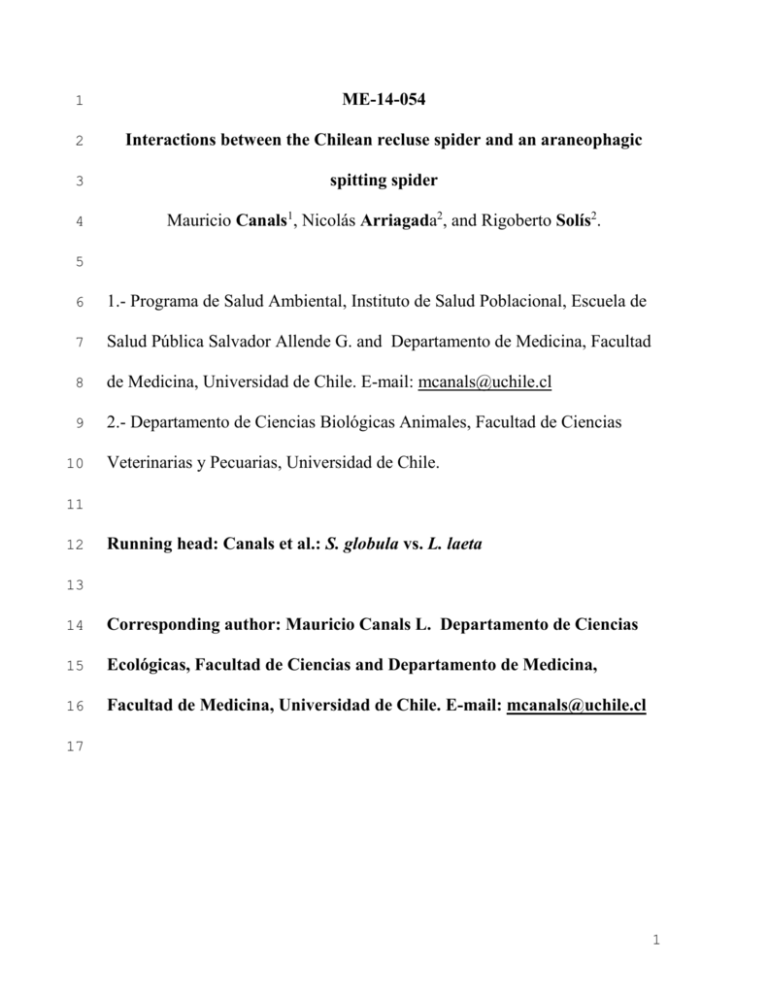
1 ME-14-054 2 Interactions between the Chilean recluse spider and an araneophagic 3 spitting spider 4 Mauricio Canals1, Nicolás Arriagada2, and Rigoberto Solís2. 5 6 1.- Programa de Salud Ambiental, Instituto de Salud Poblacional, Escuela de 7 Salud Pública Salvador Allende G. and Departamento de Medicina, Facultad 8 de Medicina, Universidad de Chile. E-mail: mcanals@uchile.cl 9 2.- Departamento de Ciencias Biológicas Animales, Facultad de Ciencias 10 Veterinarias y Pecuarias, Universidad de Chile. 11 12 Running head: Canals et al.: S. globula vs. L. laeta 13 14 Corresponding author: Mauricio Canals L. Departamento de Ciencias 15 Ecológicas, Facultad de Ciencias and Departamento de Medicina, 16 Facultad de Medicina, Universidad de Chile. E-mail: mcanals@uchile.cl 17 1 18 19 Abstract In Chile, all necrotic arachnidism is attributed to the Chilean recluse spider, 20 Loxosceles laeta Nicolet, a species that shares the micro-environmental habitats with the 21 spitting spider: Scytodes globula Nicolet. The latter species has been proposed as a 22 potential predator of L. laeta. For this research, we studied the interaction between both 23 species during individual encounters to assess the possibility of population regulation of L. 24 laeta cohorts exposed to this potential predator. We found that in most encounters S. 25 globula prevailed. Also S. globula preys on spiderlings of L. laeta with a population effect 26 on cohorts of this species. These findings suggest that S. globula may be influencing L. 27 laeta populations in central Chile. The population regulation of L. laeta by predation would 28 be important because this species, in the absence of predators, has a high reproductive rate, 29 and it can maintain populations of large size. However according to our results, although S. 30 globula may aid in the reduction of both spiderling and adult L. laeta populations, and 31 perhaps other Loxosceles species, it is insufficient for biological control of Loxosceles 32 species. Its presence together with other control measures such as hygiene of the rooms can 33 help to decrease loxoscelism incidence. 34 35 36 Key words: Loxosceles laeta, Scytodes globula, spider predation, loxoscelism. 37 2 38 39 40 Introduction 41 Loxosceles (Araneae, Sicariidae). The cases in Chile are attributed to Loxosceles laeta 42 (Nicolet) , L. gaucho Gertsch in Argentina, L.intermedia Mello-Leitão in Brazil, L. reclusa 43 Gertsch and Mulaik in the United States and L. rufescens (Dufour) in Mediterranean areas 44 (Gertsch 1967,Gertsch and Ennik 1983, Reyes et al. 1991, Vetter 2008). Loxoscelism is a health problem caused by the bite of spiders of the genus 45 In Chile, all necrotic arachnidism is attributed to the Chilean recluse spider, L. laeta, 46 a species that may be preyed upon by the spitting spider Scytodes globula Nicolet (Araneae, 47 Scytodidae). The biology of these two species is not well known (Fernandez et al. 2002, 48 Canals et al. 2004, 2008; Canals and Solís 2013, 2014; Taucare-Ríos et al. 2013). 49 Loxosceles laeta is a solitary spider of domestic habitats, found within households 50 usually in dark corners, cracks, closets, clothing and bath towels, but sometimes can be 51 found outdoors. Its activity is preferentially nocturnal; high temperatures are a factor that 52 favors its development (Schenone 1998, 2003, 2004; Schenone and Letonja 1975, 53 Schenone et al. 2001). With respect to diet, in Chile it has been reported that this spider 54 feeds on flies, moths and other small arthropods (Levi and Spielman 1964, Schenone 1998, 55 2003, 2004; Schenone et al. 1970, 1989, 2001; Parra et al. 2002). From the medical point of 56 view, the epidemiology of loxoscelism incidents coincides with nocturnal activity. 57 Epidemiology also suggests larger spider populations and greater activity during the 58 summer (Schenone 1998, 2003, 2004; Schenone et al. 2001). 59 A potential predator of L. laeta in Chile is the solitary species, S. globula, a member 60 of a group of spiders known as spitting spiders with recognized araneophagic habits 61 (Gilbert and Rayor 1985, Bowden 1991). The Scytodes spiders feed on spiders and insects 3 62 such as Diptera, Lepidoptera and Mantodea, avoiding schlerotized and aggressive prey 63 (Fernandez et al. 2002). During predation these spiders spit an adhesive substance through 64 their chelicerae, immobilizing their prey (Foelix 1996, Araujo et al. 2008). These spiders 65 are active during twilight and night and their thermal preferences and desiccation tolerances 66 are similar to those of L. laeta (Canals et al. 2013, Alfaro et al. 2013). Scytodes globula is 67 distributed in South America in Chile, Bolivia, Argentina, Brazil and Uruguay. Like L. 68 laeta, this species is common in human dwellings and gardens of houses of central Chile 69 (Fernandez et al. 2002). 70 While there are references that suggest predation on L. laeta by S. globula, there are 71 few studies that support this (Fernandez et al. 2002, Canals and Solís 2013). For example, 72 Ramíres (1999) and Ades and Ramíres (2002) documented the results of encounters 73 between S. globula and three species of Loxosceles: L. laeta, L. gaucho and L. intermedia. 74 These authors reported that within 30 minutes of introduction, virtually all L. laeta were 75 alive, although they were victims of the adhesive substance and wrapped in silk lines. Of 76 the 22 predation events recorded, on three occasions the defense of L. laeta caused leg 77 autotomy in S. globula and, in two instances, it was L. laeta which preyed on S. globula. 78 Knowing that the activity rhythms, thermal preferences and tolerance to 79 desiccation of these species are similar, it is necessary to describe the direct interaction 80 that occurs when these species meet (Hertz et al. 1993, Angilletta et al. 2002). If an 81 encounter between L. laeta and S. globula is produced, we need to know the outcome of 82 the interaction between these species both at the individual level (predatory acts) and 83 population level (ability to regulate the population) in order to determine if S. globula can 84 be an effective biological control agent (Wiedenmann 2000). 85 In this study, we analyzed the interaction between S. globula and L. laeta during 4 86 individual meetings and the possibility of population regulation of cohorts of L. laeta 87 exposed to this potential predator, with the following working hypotheses: i) as there is 88 some experimental evidence that suggests predation of L. laeta by S. globula, we propose 89 that the most common response in individual meetings of the two species will be the death 90 of L. laeta; ii) as there is some experimental evidence that suggests predation of L. laeta 91 by S. globula, we propose that this species has the potential to regulate populations of L. 92 laeta. 93 Material and methods 94 Individual interactions 95 Forty sexually differentiated individuals of L. laeta and S. globula were collected 96 inside institutional storehouses and inside human dwellings in the cities Santiago and 97 Valparaiso in Chile between December 2012 and December 2013. Sexual differentiation 98 can be recognized from 5th and from 6th moult in S. globula and L. laeta, respectively 99 (Fernandez et al. 2002, Galiano 1967, Canals and Solís 2014). The spiders were 100 maintained individually in 750 ml plastic bottles, from the reception of the individuals to 101 the beginning of the experimental trials. 102 All individuals were maintained with light: dark cycle 12:12, at 20 ± 2°C, near the 103 preferred temperature of both species (Alfaro et al. 2013) in the laboratory of Ecology and 104 Behavior of Faculty of Veterinary Sciences at the University of Chile. The temperature was 105 monitored with a maximum-minimum thermometer. Prior to the initiation of experimental 106 encounters, spiders were transferred to an incubator with inverted L:D cycle, where they 107 were maintained for at least 7 d. This allowed experimental trials to be conducted during 108 the day, but in the scotophase of the spiders. 109 Thirty-two inter-specific encounters were performed in sealed circular plastic 5 110 containers (diameter 19.5 cm; depth 7 cm). The encounters were recorded with a high 111 resolution digital video camera (SONY HDR-CX 700, USA), with night shot, in WAV 112 format. The rivals in each encounter were randomly chosen. They were sexed and their 113 body mass was measured with an analytic balance Shimadzu (AUX 220, Japan) (± 1 mg). 114 The capture and the manipulation of individuals were performed by using brushes, 115 anatomic tweezers and rubber gloves, avoiding direct contact with the spiders. 116 First, the resident spider was introduced in the experimental arena and was 117 maintained for 1 wk for habituation before the encounter. Thirty-two individuals of L. laeta 118 (66.21 ± 90.30 mg) and 32 individuals of S. globula (76.33 ± 23.87 mg), with a body mass 119 ratio R = mass of S. globula / mass of L. laeta = 0.607 ± 0.448, were used in the 120 encounters. Sixteen individuals of L. laeta (Ll) were male (mb = 105.21 ± 48.75 mg) and 16 121 female (mb = 238.82 ± 66.14 mg), and 18 individuals of S. globula (Sg) were male (mb = 122 71.17 ± 21.68 mg) and 14 female (mb = 82.80 ± 24.76 mg). The encounters were 123 distributed in the following form: 7 Sg♂-Ll♂, 11 Sg♂-Ll♀, 9 Sg♀-Ll♂ and 5 Sg♀-Ll♀. In 124 16 of the 32 encounters, S. globula was the resident spider and in 16 it was the intruder. At 125 the beginning of the encounter, the new individual was introduced at 10 cm from the 126 resident spider. The experimental trials lasted at least 60 min, ending when one spider 127 killed and sucked its prey at least for 20 min. In case when both were alive at the end of 60 128 min, the experiment lasted another 60 min. If neither were attacked or killed, the encounter 129 was considered a draw. 130 In the videos, the frequency and the sequence of the behavioral events during spider 131 interactions were recorded and analyzed, where an aggressive encounter was defined as 132 physical contact between the spiders, resulting in the death of one spider. The description 133 and nomenclature of behavioral events followed Gilbert and Rayor (1985) and Fernández et 6 134 al. (2002) for the construction of the ethogram. The 10 behavioral events considered were: 135 1. Alert posture, 2. Leg retraction, 3. Tapping, 4. Prey palpation, 5. Spitting, 6. Scraping 136 (reciprocal rasping of pedipalps and cutting the threads of the web), 7. Reach (prey 137 capture), 8. Roll (enveloping), 9. Biting, and 10. Nibbling. In each experiment, the death of 138 the spiders and leg loss by S. globula were recorded. 139 With the behavioral event sequence that formed the ethogram, a flux diagram was 140 built indicating the frequency of the events. The frequency of aggressive encounters in 141 relation to the total number of encounters was recorded, and the proportion of aggressive 142 encounters (PA = number of aggressive encounters/ total number of encounters) and their 143 confidence intervals (CI0,95= (p ± 1,96 √(pq/n)) were calculated. Also, the proportion of 144 victories of S. globula was recorded (PV= number of victories of Sg/number of aggressive 145 encounters) with its confidence interval. The effect of residency (resident vs. intruder) on 146 PA and PV was analyzed with the Fisher exact test, which provides the exact p-value 147 (Fisher p) for proportion differences for small n. The effects of the body mass of S. globula, 148 the body mass of L. laeta and the body mass ratio on PA and PV of each spider was 149 analyzed by logistic regression. The models were: logit (*) = β0 + β1MbSg, logit (*) = β0 + 150 β1MbLl, and logit (*) = β0 + β1R, where MbSg is the body mass of S. globula, MbLl the body 151 mass of L. laeta, R the body mass ratio and (*) was PA or PV whichever variable was 152 studied. To study interactions between MbSg and sex in aggressive encounters and in 153 victories of S. globula we consider three body mass intervals: small MbSg < 70 mg; 154 medium 70 mg < MbSg < 100 mg and large MbSg > 100 mg and we performed χ2 test in the 155 sex-body mass contingency tables. 156 Effect on cohort development 157 Six adult females of L. laeta with their egg sac were captured and introduced 7 158 separately in a plastic box of 35x25x20 cm during summer season. Boxes were held at 159 ambient laboratory temperatures to simulate that of unheated houses in Santiago. 160 Temperature and relative humidity inside the box were recorded with a digital Sychrometer 161 with remote probe AZ8723 (AZ Instruments Corp, England). The six boxes were 162 maintained with light: dark cycle 12:12 and were placed on a rack and randomly rotated 163 every 2 wk to avoid effects due to the particular position of each box. These spiders, with 164 their egg sacs were maintained until eclosion of the spiderlings. Each of spiders with their 165 egg sacs were randomly assigned into either experimental group: Sg(-): a group of three 166 cohorts that developed without S. globula and Sg(+), a group of three cohorts in which an 167 adult S. globula captured in Santiago was introduced into the box. Beginning at eclosion 168 (day 0), the spiderlings were inspected and counted every 2 wk, recording the number of 169 survivors, the dead individuals and the exuvia. The day 0 for each cohort were: Sg(-)1: 170 December 20; Sg(-)2 Sg(+)1,Sg(+)2: January 1; and Sg(-)3, Sg(+)3: February 7. The dead 171 spiderlings and exuvia were removed. Spiderling instars were determined by counting the 172 exuvia and comparing these with the morphological characteristics of the spiderlings 173 described by Galiano (1967) and Galiano and Hall (1973). 174 At each inspection, the individuals were photographed at 50 cm distance with a 175 reference mark of known dimensions. At this time, 10 mealworm larvae (Tenebrio molitor 176 L.) were introduced in the box. These larvae vary in size during development, so that larvae 177 at an appropriate size to be handled by the spiderlings (at most three times their body size) 178 were chosen. Also, 10 drops of water were deposited in the corner of the box to provide 179 humidity. In the Sg(+) cohorts, the spiderlings were initially maintained with their mothers 180 until the latter was killed by a S. globula. In Sg(-) cohorts, the L. laeta mother was removed 181 at the date equivalent to the death of a mother in a Sg(+) cohort. When the adult of S. 8 182 globula died, it was replaced by a new adult of this species. A total of 11 adult S. globula, 5 183 females and 6 males, were used during the experiment. Thus, Sg(+) cohorts always had 184 one predator inside the box. During each inspection, the spiderlings were observed for 20 185 min, recording and photographing activities such as predation and cannibalism. 186 At each inspection, the number of live spiderlings was recorded (N). From 187 photographs, the body length (prosoma + opistosoma) of all spiderlings whose position 188 permitted measurement was recorded. The measurements were made with ImageJ 1.32 189 software (NIH, U.S.A). 190 In each cohort, the number of spiderlings alive on each count occurrence was 191 divided by the initial number placed in the box (N/No), and a regression model was fitted, 192 ln(100N/No) = b1t + bo. This allowed us to estimate the mortality rate (μ = │b1│). The 193 curves generated between treatments were compared with ANCOVA for homogeneity of 194 slopes, considering the cohorts as the independent variables, ln (100N/No) as the response 195 variable and time as the co-variable. Planned comparisons were performed to contrast 196 Sg(+) and Sg(-) cohorts. 197 Linear regressions were performed between mean body size (mbs) and time (t) and 198 between maximum body size (Mbs) and time. The models were (*) = β0 + β1 t, where (*) 199 was mbs or Mbs, depending on the variable analyzed. The progression of these variables 200 was compared with ANCOVA, considering only the length of the experiment where all 201 cohorts had live spiderlings (171 days). 202 Results 203 Individual interactions 204 205 In the encounters in which S. globula was the winner, the predator behaviors: tapping, spitting, scrapping, reach and roll, biting and nibbling were observed in 100% of 9 206 207 cases. Alert posture was observed in 80% and leg retraction in 40%, (Fig. 1). Of the 32 encounters, 19 aggressive encounters were observed: PA = 0.594 ± 208 0.087; CI0.95: [0.474; 0.664]. Of these, S. globula was the winner in 13 of the encounters, 209 obtaining PV = 0.684 ± 0.106 CI0.95: [0.475; 0.893].Leg loss by S. globula was observed 210 only on one occasion (3.13%). This individual was killed by L. laeta. 211 The sex of fighters did not affect the probability of aggressive encounter. Of the 18 212 male and 14 female S. globula used in the study, nine aggressive encounters were observed 213 by males and in 10 by females providing a 50% (CI0.95: [26.9 ; 73.1]) and 71.4% aggression 214 percentage (CI0.95: [47.7 ; 95.1]), (Fisher p = 0.29). Similar results were observed with L. 215 laeta wherein eight of 16 aggressive encounters occurred with males (50%; CI0.95: [25.5; 216 74.5]) and eleven of 16 aggressive encounters with females (68.8%; CI0.95: [46.1 ; 91.5]) 217 (Fisher p = 0.48). The sex of fighters also did not affect the probability of victory. Five 218 male (55.6%; CI0.95: [23.1 ; 88.1]) and eight female (80.0%; CI0.95: [55.2 ; 100]) S. globula 219 were winners (Fisher p = 0.35), while three female and three male L. laeta were winners 220 (Fisher p ≈ 1). 221 There were no differences in PA when S. globula was the resident spider, 0.438 ± 222 0.124, CI0.95: [0.195 ; 0.681] or when it was the intruder: 0.75 ± 0.108, CI0.95: [0.538 ; 223 0.962] (Fisher p = 0.149) or in PV between when S. globula was resident: 0.857 ± 0.132, 224 CI0.95: [0.598 ; 1.000] or when it was the intruder: 0.583 ± 0.142, CI0.95: [0.304 ; 225 0.862](Fisher p = 0.331). 226 Body mass of S. globula adequately predicted PA (logit(PA) = -3.66 + 0.055mb, 227 Wald = 4.738, p = 0.029; probability of good classification (PGC) = 0.533) and also 228 adequately predicted PV (logit(PV) = -8.03 + 0.062mb, Wald = 3.872, p = 0.049; PGC 229 =0.833)) (Fig. 2). Interactions between body mass and sex were not found (χ2 = 2.8, p = 10 230 0.24 and χ2 = 2.3, p = 0.32 for aggressive encounters and victories of S. globula 231 respectively). In contrast, the mass ratio R did not predict PA well (logit(PA) = 0.727 + 232 1.138R, Wald = 1.997, p = 0.158) or PV (logit(PV) = 1.332 + 2.587R, Wald = 1.928, p = 233 0.165). Also, the body mass of L. laeta did not predict PA (logit(PA) = 0.793 + 0.004mbLl, 234 Wald = 0.193, p = 0.66) or PV of this species (logit(PV) = 1.395 -0.004 mbLl, Wald = 235 0.431, p = 0.521). 236 237 238 Effect on cohort development The environmental conditions of the two experimental groups were the same (Fig. 239 3). In two of the Sg(-) cohorts, 79 and 106 spiderlings emerged from the egg sac. In the 240 third cohort, an exceptionally low number of 12 spiderlings emerged from the egg sac. In 241 Sg(+) cohorts 146, 81 and 101 spiderlings emerged from the egg sac. 242 In the three Sg(+) boxes, eight adult predator spiders were necessary to achieve the 243 establishment of the predators. In five introductions L. laeta killed S. globula (three males 244 and two females) while in the other three opportunities, three males of S. globula killed the 245 three established female L. laeta. 246 After more than 550 experimental days all Sg(-) cohorts had live adult spiders. In 247 the Sg(-) containers, the longest surviving L. laeta had molted up to 10 times and survived 248 from 517-566 days. In contrast, in all Sg(+) containers, all spiderlings were dead at 182, 249 270 and 275 days post-predator introduction for cohorts 1-3, respectively. In the latter 250 cohorts only three molts were obtained, while in the same time frame in Sg(-) cohorts two 251 to seven molts were observed among spiderlings. 252 A higher daily mortality rate of the spiderlings was obtained in Sg(+) cohorts 253 (0.0201 ± 0.001276) than in Sg(-) cohorts (0.010572 ± 0.000991) (F5,86 = 3.017, p < 0.001; 11 254 Planned comparisons: F1,86 = 20176.7, p < 0.001) was obtained (Fig. 4). The mortality rates 255 for each cohort were: Sg(-)1: 0.012 ±0.0006 (R2 = 0.96, p < 0.001), Sg(-)2: 0.011 ± 0.0013 256 (R2 = 0.81, p < 0.001), Sg(-)3: 0.006 ±0.0004 (R2 = 0.96, p < 0.001), Sg(+)1: 0.024 ±0.0027 257 (R2 = 0.86, p < 0.001), Sg(+)2: 0.018 ±0.0027 (R2 = 0.92, p < 0.001), Sg(+)3: 0.022 ±0.0016 258 (R2 = 0.92, p < 0.001). 259 During equivalent time periods, the mean body length of the spiderlings was similar 260 in all cohorts, but the maximum body length during this time was 3.92 ± 0.24 mm in Sg(-) 261 cohorts and 3.17 ± 0.07 mm in Sg(+) cohorts (F1,66 = 55.32, p < 0.001). Furthermore in 262 Sg(+) the variance was lower (Bartlett test = 46.2, p < 0.001). The slope of maximum body 263 length increase was different among all cohorts (F5,66 = 3.54, p < 0.001). Also when Sg(-) 264 and Sg(+) groups were compared, a significant difference was found (F1,74 = 25.84, p < 265 0.001) (Fig. 5). 266 Discussion 267 In studying behavioral responses of S. globula using a different prey species, 268 Fernández et al. (2002) described S. globula as expressing all behavioral displays reported 269 in this study, but to a greater extent. For example, in our study alert posture and leg 270 retraction only were observed in 80% and 40% of cases, respectively (Fig. 1). Interestingly, 271 of the 10 behavioral displays described by these authors, we only recognized eight in an 272 isolated form. Tapping always occurred with prey palpation, while reach always occurred 273 with roll and thus were considered a single event. 274 When a predatory event occurred, the sequence of events by S. globula was not 275 always the same. For example, in three of 32 encounters, the tapping display was repeated 276 alternating with other displays, such as spitting, reach and roll and biting. Tapping display 12 277 may be part of a strategy destined to ensure the immobility of the prey before nibbling. 278 Also, during tapping display S. globula more frequently used the left first and second leg, 279 than the right legs, agreeing with that reported by Ades and Ramires (2002). These 280 behavioral displays, favored by the length of the legs, could increase its success of survival 281 by reducing the risk of counterattack during a predatory event. Spitting is used to 282 immobilize prey (Gilbert and Rayor 1985), increasing the probability of predatory success. 283 The probability of an aggressive encounter, a situation where interactions led to the 284 death of one of the spiders, was only moderate, occurring in only approximately 60% of the 285 occasions, which may be related to motivational factors of the predator or the prey. For 286 example, one evident factor would be the time lapse since the predator last meal. This 287 factor was partially controlled by the time of acclimation in laboratory, which ensured at 288 least two to three weeks without prey. Neither the sex of the predator nor that of the prey, 289 regardless of which species was the resident, had an effect on the probability of an 290 aggressive encounter or the probability that S. globula was the winner of these encounters. 291 This probability was only moderately high, 68.4%, which may be a consequence of the fact 292 that the prey, L. laeta, was a larger and is considered a quicker spider (Canals et al. 2008) 293 that exceeded by 64% the body mass of S. globula. Loxosceles laeta aggressive behavior 294 was especially striking when encountering S. globula adults in the three Sg(+) chambers 295 that contained a L. laeta female with her young. Such a challenge with spider introductions 296 was previously described by Canals and Solís (2013) who stressed the special situation 297 represented by a large female guarding her spiderlings being confronted by a predator. In 298 their study, they documented the offspring-guarding female expressing high 299 aggressiveness, and they attributed this to the likely need for increased food intake leading 13 300 to the aggressive behavior and thus becoming a more difficult prey. This idea is reinforced 301 because the spiders in general appear to be territorial, especially at low prey availability 302 (Riechert 1981). 303 In the individual encounters we only observed a 3.1% leg loss level among S. 304 globula. However in the Sg(+) chambers, leg loss occurred in 3 of 8 encounters (37.5%). 305 Previous reports of encounters between S. globula and the species L. laeta, L. gaucho and 306 L. intermedia suggested a 13.6% leg loss level (Ades and Ramires 2002), which is between 307 these two values. 308 Of all analyzed predictors of an aggressive encounter and a victorious encounter by 309 S. globula, only the body mass of S. globula was a good predictor of both PA and PV. The 310 greater the body mass of S. globula, the higher the PA and PV values by S. globula were. 311 The body mass of the sub-adults and adults of S. globula used in this study varied between 312 23.8 and 123.7 mg, and the variations in mass represented variations in developmental 313 instars. It appears that the effect of the body mass on PA and PV would be explained by the 314 experience and ability of the predator acquired during its development. All individuals of S. 315 globula with body mass over 85 mg had aggressive encounters and all resulted in winners. 316 (see Fig. 2). 317 All Sg(-) cohorts still had live spiders and in all Sg(+) cohorts all spiderlings were 318 killed before reaching at most the fourth instar, with a maximum body size lower than that 319 of Sg(-) spiderlings after an equivalent time period. Furthermore, the mortality rate in Sg(+) 320 cohorts was about twice that of Sg(-) cohorts. Predation of spiderlings by the mother was 321 not observed, contrasting with several predation events on T. molitor larvae. This fact, the 322 short time that spiderlings share with their mothers and that this time was matched for the 323 experimental groups allows discard predation by the mother as a cause of differential 14 324 mortality rate among the experimental groups. The mortality rate in both experimental 325 groups is explained in part by natural causes and spiderling cannibalism, which was 326 observed on two occasions during the inspection of different cohorts and was described for 327 L. laeta (Vetter and Rust 2010). Although the actual amount of cannibalism during the 328 experiments was not recorded because the boxes were inspected only once every 2 wk, the 329 cannibalism event numbers would have been similar across the six boxes, because the 330 similar maintenance conditions. We believe that the presence of the predator in the three 331 Sg(+) boxes did not result in more cannibalism events due to the sharing of the larvae with 332 the predator, because S. globula has a marked preference for less chitinous prey (Fernandez 333 et al. 2002), and during the inspections when the mealworm larvae were introduced the 334 spiderlings immediately preyed and fed on them. 335 In the Sg(+) cohorts, the predation of spiderlings by an adult S. globula was added 336 to these causes of mortality, and was directly observed on three occasions during the count 337 of the spiderlings. Thus the difference in mortality between the experimental groups is 338 attributable to predation and represents the maximum potential effect of S. globula on the 339 mortality rate of cohorts of L. laeta. Provided our experimental design, the difference in the 340 body size between the spiderlings of the experimental groups and the absence of later 341 instars in the predator-positive treatment is likely explained by predation of the larger 342 individuals by S. globula. 343 In Chile, S. globula is found inside human dwellings, alone or coexisting with L. 344 laeta, (Fernandez et al. 2002, Canals and Solis 2013). In other countries, S. globula has 345 been reported outside of human dwellings, as a peridomiciliary spider (Fischer and 346 Vasconcellos-Neto 2005b). Spiders of the genus Loxosceles frequently are found with other 347 spider families such as Pholcidae, Theridiidae, Salticidae and Selenopidae, but the 15 348 interaction of members of these families with Loxosceles species has been poorly studied 349 (Sandidge 2004, Fischer et al. 2006). In Chile, only S. globula has been reported as a 350 predator of L. laeta (Fernandez et al. 2002, Canals and Solís 2013). Interactions between L. 351 intermedia and Pholcus phalangioides (Fuesslin) have been studied in Brazil. Loxosceles 352 species were frequently found in the web of P. phalangioides, but without clear population 353 effects (Fisher and Krechemer 2007). These authors found that P. phalangioides preyed on 354 adults and spiderlings of L. gaucho, L. laeta and L. hirsuta Mello-Leitao. Sandidge (2004) 355 reported predation of L. reclusa by three cosmopolitan, synanthropic spiders: P. 356 phalangioides (Pholcidae), Achaearanea tepidariorum (Koch) (Theridiidae) and Steatoda 357 triangulosa Walckenaer (Theridiidae), reporting that only the latter two spiders had a 358 negative, but non-significant population relationship with L. reclusa. Sandidge (2004) did 359 not find individuals of L. reclusa in P. phalangioides webs, a fact that he explained by a 360 different spatial distribution of the species; L. reclusa was found in webs at floor level, P. 361 phalangioides was found in webs in high corners near the ceiling of the rooms. However, 362 Fisher and Krechemer (2007) reported that this fact might be explained by the custom of P. 363 phalangioides of removing and rebuilding their webs. 364 Food availability may be an important factor to explain the results of Fisher and 365 Krechemer (2007) and Sandidge (2004), because the spiders studied by these authors are 366 opportunistic spiders that usually feed on insects. In contrast, S. globula although feed on 367 insects such as Diptera, Lepidoptera and Mantodea, is mainly an araneophagic spider that 368 preys on several Loxosceles species and other spiders such as Salticidae and spiders of the 369 genus Drassodes (Jackson et al. 1998, Ades and Ramires 2002, Fernandez et al. 2002, 370 Canals and Solís 2013). 16 371 In Chile, S. globula shares the habitat and the preferred micro-environments with L. 372 laeta inside human dwellings, preying naturally on L. laeta (Fernandez et al. 2002, Canals 373 and Solís 2013). Thermal preferences and desiccation tolerances suggest that the species 374 share more than 80% of their thermal niche (Alfaro et al. 2013, Canals et al. 2013). Both 375 species are nocturnal, making encounters between them highly probable. This study 376 showed that on most occasions this encounter has a favorable result for S. globula. But 377 also, in a considerable proportion of interactions, L. laeta preys on S. globula. Our results 378 demonstrate that under the laboratory conditions used herein, S. globula preyed on 379 spiderlings of L. laeta with a clear effect on the mortality rate of cohorts of this species. 380 However, there is a report of co-existence of adults and spiderlings of both species in areas 381 smaller than 1 m2 (Canals and Solís 2013). These findings suggest that S. globula is 382 naturally interacting with the population of L. laeta in central Chile. The population 383 regulation of L. laeta by predation would be important because this species, in the absence 384 of predation, has a high basic reproductive rate, Ro = 2.1, and it can maintain large 385 populations with high dispersion capacity (Canals and Solís 2014). However according to 386 our results, although S. globula may impact the number of spiderlings and adults of L. laeta 387 and perhaps other Loxosceles species in a co-existing environment, S. globula is not an 388 efficient biological control agent suitable for Loxosceles species management. Its presence, 389 however, together with other control measures such as hygiene and cleaning of infested 390 rooms, may help to decrease loxoscelism incidents. 391 392 393 394 Acknowledgements We thank Lafayette Eaton for his useful comments on the manuscript. Funded by FONDECYT 1110058 grant to MC. 17 395 396 397 398 399 400 401 402 403 404 405 406 407 References cited Ades, C., and E.R. Ramires. 2002. Asymmetry of leg use during prey handling in the spider Scytodes globula (Scytodidae). J. Insect. Behav. 15: 563-570. Alfaro, C., C. Veloso, H. Torres-Contreras, R. Solís, and M. Canals. 2013. Thermal niche overlap of the spider of the nook Loxosceles laeta (Araneae; Sicariidae) and its possible predator, the tiger spider Scytodes globula (Scytodidae). J. Therm. Biol. 38: 502507. Angilletta, M.J.J., P. H. Niewiarovski, and C.A. Navas. 2002. The evolution of thermal physiology in ectotherms. J. Therm. Biol. 27: 249-268. 408 409 410 Araujo. D., A. Rheims, D. Brescovit, and D. Cella. 2008. Extreme degree of chromosome number variability in species of the spider genus Scytodes (Araneae, Haplogynae, Scytodidae) J. Zool. Syst. Evol. Res. 46: 89-95. 411 412 413 Bowden, K. 1991. The evolution of sociality in the spitting spider Scytodes fusca (Araneae, Scytodidae) evidence from observations of intraspecific interactions. J. Zool. 223: 161– 172. 414 415 416 417 418 419 420 421 422 423 424 425 426 427 428 429 430 431 432 433 434 435 436 437 438 Canals, M., C. Alfaro, C. Veloso, H. Torres-Contreras, and R. Solís. 2013. Tolerancia a la desecación y sobreposición del nicho térmico entre la araña del rincón Loxosceles laeta y un posible control biológico, la araña tigre Scytodes globula. Parasitología IberoLatinoamericana 72(1): 52-60. Canals, M., M.E. Casanueva, and M. Aguilera. 2004. Cuales son las especies de arañas peligrosas en Chile? Rev. Med. Chile 132: 773-776. Canals, M., M.E. Casanueva, and M. Aguilera. 2008. Arañas y escorpiones, pp.145-183. In Canals, M. and P.E. Cattan (eds.), Zoología Médica II. Invertebrados. Editorial Universitaria, Santiago, Chile. Canals, M., and R. Solís. 2013. Is the tiger spider Scytodes globula an effective predator of the brown recluse spider Loxosceles laeta? Rev. Med. Chile. 141: 805-807. Canals M., and R. Solís. 2014. Desarrollo de cohortes y parámetros poblacionales de la araña del rincón Loxosceles laeta. Rev. Chil. Infectol. 31: 547-554. Fernandez, D., L. Ruz, and H. Toro. 2002. Aspectos de la biología de Scytodes globula Nicolet, 1949 (Araneae: Scytodidae), un activo depredador de Chile Central. Acta Entomol. Chil. 26: 17-25. Fisher, M.L., and J. Vasconcellos-Neto. 2005a. Development and life tables of Loxosceles intermedia Mello-Leitao 1934 (Araneae, Sicariidae). J. Arachnol. 33: 758-766. 18 439 440 441 442 443 444 445 446 447 448 449 450 451 452 453 454 455 456 457 458 459 460 461 462 463 464 465 466 467 468 469 470 471 472 473 474 475 476 477 478 479 480 481 482 483 484 485 Fisher, M.L., and J. Vasconcellos-Neto. 2005b. Microhabitats occupied by Loxosceles intermedia and Loxosceles laeta (Araneae, Sicariidae) in Curitiba, Paraná, Brazil. J. Med. Entomol. 42: 756-765. Fisher, M.L., J. Vasconcellos-Neto, and L. Gonzaga. 2006. The prey and predators of Loxosceles intermedia Mello-Leitao 1934 (Araneae, Sicariidae). J. Arachnol. 34:485-488. Fisher, M. L., and F. Krechemer. 2007. Interacoes predatórias entre Pholcus phalangioides (Fuesslin) (Araneae, Pholcidae) e Loxosceles intermedia Mello-Leitao (Araneae, Sicariidae). Rev. Bras. Zool. 24: 474-481. Foelix, R.E. 1996. Biology of Spiders. Oxford University Press, Oxford. Galiano, M. 1967. Ciclo biológico y desarrollo de Loxosceles laeta. Acta Zool. Lill. 23: 431-464. Galiano, M., and M. Hall. 1973. Datos adicionales sobre el ciclo vital de Loxosceles laeta. Physis C 32: 277-88. Gertsch, W.J. 1967. The spider genus Loxosceles in South America (Araneae, Scytodidae) Bull. Amer. Mus. Nat. Hist. 136: 117-174. Gertsch, W.J., and F. Ennik. 1983. The spider genus Loxosceles in North America, Central America and the West Indies (Araneae, Loxoscelidae). Bull. Amer. Mus. Nat. Hist. 175: 264-360. Gilbert, C., and L.S. Rayor. 1985. Predatory behavior of spitting spiders (Araneae, Scytodidae) and the evolution of prey wrapping. J. Arachnol. 13: 231-241. Hertz, P., R. Huey, and R. Stevenson. 1993. Evaluating temperature regulation by fieldactive ectotherms: the fallacy of the inappropriate questions. Amer. Natur. 142: 796-818. Jackson, R.R., D. Li, N. Fijn, and A. Barrion. 1998. Predator-prey interactions between aggressive-mimic jumping spiders (Salticidae) and araneophagic spitting spiders (Scytodidae) from Philippines. J. Insect. Behav. 11: 319-342. Levi, H.W., and A. Spielman. 1964. The biology and control of the South American brown spider Loxosceles laeta (Nicolet) in a North American focus. Am. J. Trop. Med. Hyg. 13: 132-136. Parra, D., M. Torres, J. Morillas, and P. Espinoza. 2002. Loxosceles laeta, identificación y una Mirada bajo microscopía de barrido. Parasitol. Latinoamer. 57: 75-78. Ramires, E.N. 1999. Uma abordagem comparativa ao comportamento defensivo, agonístico e locomotor de três espécies de aranhas do gênero Loxosceles (Sicariidae). Doctoral Thesis, Institute of Psychology, University of Sao Paulo, Brazil. 19 486 487 488 489 490 491 492 493 494 495 496 497 498 499 500 501 502 503 504 505 Reyes, H., I. Noemi, B. Gottlieb. 1991. Arácnidos y otros artrópodos ponzoñosos, pp: 553-565. In Atías, A. (ed.) Parasitología clínica, Mediterraneo, Santiago. 506 507 508 509 510 511 512 513 514 515 516 517 518 519 520 521 522 523 524 525 526 527 528 529 530 Schenone, H., A. Rojas, H. Reyes, F. Villarroel, and G. Suarez. 1970. Prevalence of Loxosceles laeta in houses in central Chile. Am. J. Trop. Med. Hyg. 19: 564–567. Riechert, S.E. 1981. The consequences of being territorial: spiders a case of study. Amer. Natur. 117: 871-892. Sandidge, J. 2004. Predation by cosmopolitan spiders upon the medically significant pest species Loxosceles reclusa (Araneae, Sicariidae): limited possibilities for biological control. J. Econ. Entomol. 97: 230-234. Schenone, H. 1998. Loxoscelismo cutáneo de predominio edematoso. Bol. Chil. Parasitol. 53: 78-83. Schenone, H. 2003. Cuadros tóxicos producidos por mordedura de araña en Chile: latrodectismo y loxoscelismo. Rev. Med. Chile 131: 437-444. Schenone, H. 2004. A propósito del loxoscelismo en Chile. Rev. Med. Chile 132: 121-122. Schenone, H., and T. Letonja, T. 1975. Notas sobre la biología y distribución geográfica de las arañas del género Loxosceles. Bol. Chil. Parasitol. 30: 27-29. Schenone, H., S. Rubio, S. Saavedra, and A. Rojas. 2001. Loxoscelismo en pediatría: Region metropolitana, Chile. Rev. Chil. Pediatr. 72: 100-109. Schenone, H., T. Saavedra, A. Rojas, and F. Villarroel. 1989. Loxoscelismo en Chile. Estudios epidemológicos, clínicos y experimentales. Rev. Inst. Med. Trop. Sao Paulo 31: 403–415. Taucare-Ríos, A., Brescovit, D., and M. Canals. 2013. Synanthropic spiders (Arachnida: Araneae) from Chile, the most common spiders in anthropogenic habitats. Rev. Iber. Aracnol. 23: 49-56. Vetter, R. S. 2008. Spiders of the genus Loxosceles (Araneae, Sicariidae), a review of biological, medical and psychological aspects regarding envenomations. J. Arachnol. 36: 150-163. Vetter, R.S., and M. K. Rust. 2010. Periodicity of molting and resumption of post-molt feeding in the brown recluse spider Loxosceles reclusa (Araneae, Sicariidae). J. Kansas Entomol. Soc. 83: 306-312. Wiedenmann, R. 2000. Introduction to biological control. Institute for biological control, Illinois. 20 531 532 533 534 535 536 537 538 539 540 541 542 543 544 545 546 547 548 549 550 551 552 553 Figure legends Figure 1. Ethogram of predatory behaviors expressed by adult Scytodes globula Nicolet when encountering adult Loxosceles laeta Nicolet during paired interspecific encounters in 19.5 cm circular chambers. Figure 2. Logistic regressions between the A) probability of aggressive encounter (PA) and B) probability of victory (PV) by adult Scytodes globula Nicolet on the body mass (g) of S. globula (Mb) in paired interspecific encounters with adult Loxosceles laeta Nicolet in 19.5 cm circular chambers. Figure 3.- Variation of temperature and relative humidity during the experimental time in Sg(-) and Sg(+) cohorts. Figure 4. Loxosceles laeta Nicolet spiderling cohort survival rate, expressed as (ln(100N/No)) in chambers without Scytodes globula Nicolet (Sg(-)) and in chambers with one adult S. globula (Sg(+)). Figure 5. Regression lines between the maximum body size (Mbs) of Loxosceles laeta Nicolet spiderlings without a Scytodes globula Nicolet (Sg(-)) (Mbs1) and with S. globula (Sg(+)) (Mbs2) and time. 21

